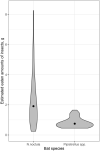Quantitative evaluation of individual food intake by insectivorous vespertilionid bats (Chiroptera, Vespertilionidae)
- PMID: 34096574
- PMCID: PMC8214420
- DOI: 10.1242/bio.058511
Quantitative evaluation of individual food intake by insectivorous vespertilionid bats (Chiroptera, Vespertilionidae)
Abstract
Insectivorous bats provide important ecosystem services, especially by suppressing and controlling the insects' biomass. To empirically quantify the number of insects consumed by European vespertilionid bats per night, we estimated their ratio of dry mass of feces to mass of consumed insects. This study combines the results of feeding in captivity and the data obtained in field surveys; dry mass of feces was measured in both cases. In captivity, we analyzed the effect of species, age and sex of bats, species of insects consumed and the mass of food portion on the dry mass of feces. Using coefficients of the regression model, we estimated the number of insects consumed by free-ranging bats based on dry mass of their feces. According to our estimates, on average, one individual of one of the largest European bat species, Nyctalusnoctula, consumes 2.2 g (ranging from 0.5 to 8.2 g) of insects per one feeding night, while the smallest European bats of genus Pipistrellus consume 0.4 g (ranging from 0.1 to 1.3 g), further confirming the importance of insectivorous bats for ecosystem services. This publication offers the novel method for the estimation of insects' biomass consumed by bats.
Keywords: Chiroptera; Ecosystem services; Insectivorous bats; Insects; Ukraine.
© 2021. Published by The Company of Biologists Ltd.
Conflict of interest statement
Competing interests The authors declare no competing or financial interests.
Figures


Similar articles
-
Predator-prey interaction reveals local effects of high-altitude insect migration.Oecologia. 2018 Jan;186(1):49-58. doi: 10.1007/s00442-017-3995-0. Epub 2017 Nov 3. Oecologia. 2018. PMID: 29101468
-
Going out for dinner-The consumption of agriculture pests by bats in urban areas.PLoS One. 2021 Oct 21;16(10):e0258066. doi: 10.1371/journal.pone.0258066. eCollection 2021. PLoS One. 2021. PMID: 34673777 Free PMC article.
-
Do bigger bats need more time to forage?Braz J Biol. 2008 Nov;68(4):819-22. doi: 10.1590/s1519-69842008000400017. Braz J Biol. 2008. PMID: 19197500
-
Bats and their vital ecosystem services: a global review.Integr Zool. 2022 Jan;17(1):2-23. doi: 10.1111/1749-4877.12552. Epub 2021 Jun 8. Integr Zool. 2022. PMID: 34003577 Review.
-
Reproduction of Rescued Vespertilionid Bats (Nyctalus noctula) in Captivity: Veterinary and Physiologic Aspects.Vet Clin North Am Exot Anim Pract. 2017 May;20(2):665-677. doi: 10.1016/j.cvex.2016.11.013. Epub 2017 Feb 4. Vet Clin North Am Exot Anim Pract. 2017. PMID: 28169186 Review.
Cited by
-
Bat Ecology and Microbiome of the Gut: A Narrative Review of Associated Potentials in Emerging and Zoonotic Diseases.Animals (Basel). 2024 Oct 21;14(20):3043. doi: 10.3390/ani14203043. Animals (Basel). 2024. PMID: 39457973 Free PMC article. Review.
-
Optimally warm roost temperatures during lactation do not improve body condition in a long-lived bat.Biol Lett. 2024 Oct;20(10):20240346. doi: 10.1098/rsbl.2024.0346. Epub 2024 Oct 23. Biol Lett. 2024. PMID: 39439359
References
-
- Aizpurua, O. and Alberdi, A. (2020). Mapping the pressure of natural predators on pest arthropods. Authorea (Preprint). 10.22541/au.158981075.53963117. - DOI
-
- Alekseeva, E. I., Panutin, K. K. and Topilina, V. G. (1980). To the study of quantitative aspects of the nutrition of bats. In Rukokrylye (Chiroptera), pp. 184-187. Kiev: Nauka.
-
- Anthony, E. L. and Kunz, T. H. (1977). Feeding strategies of the little brown bat, Myotis lucifugus, in southern New Hampshire. Ecology 58, 775-786. 10.2307/1936213 - DOI
-
- Beck, A. (1995). Fecal analyses of European bat species. Myotis 32-33, 109-119.
Publication types
MeSH terms
LinkOut - more resources
Full Text Sources

